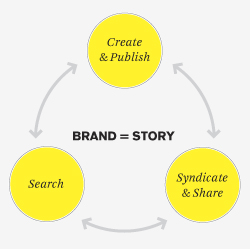 The latest news from the upper-echelons of marketing and advertising is that storytelling is the path to advertising’s future. There’s still a lot of what can be called “TV thinking” hanging on stubbornly, but no one any longer denies the basics — which, if you’ll allow us a short moment of tooting our own horn, is exactly what we’ve been preaching at Story Worldwide for the past five years.
The latest news from the upper-echelons of marketing and advertising is that storytelling is the path to advertising’s future. There’s still a lot of what can be called “TV thinking” hanging on stubbornly, but no one any longer denies the basics — which, if you’ll allow us a short moment of tooting our own horn, is exactly what we’ve been preaching at Story Worldwide for the past five years.
Recently, I became a Global Advisory Board Member of The Future of Advertising Project. This is possibly the most pretentious title I’ve ever had and the most portentously named project I’ve even participated in. But it’s the real deal. The project is being run by The Wharton Business School at the University of Pennsylvania with help from the prestigious Advertising Research Foundation. Some of the other partners, besides Story, will sound familiar: Google, for example, is supplying a bunch of the funding and some of the ideas. MDC Partners, WPP, Y&R, Radical Media (recently purchased by Fremantle Media) and many other big agencies are involved, along with senior clients from Kodak, Unilever, Commerzbank and so on. It’s a pretty heavy-weight group and I’m very proud that Story was asked to join.
The consensus at my first board meeting of The Future of Advertising Project was that conventional advertising, in fact, has a very limited future. The project’s leader, Yoram “Jerry” Wind, a senior marketing professor at Wharton, believes that “advertising” is an outmoded term. But he says we don’t yet possess the terminology to speak about what’s replacing advertising. I, of course, suggested “post-advertising,” which got some attention and understanding (“like postmodern!”) but not wide adoption.
But when I presented a single-slide vision of advertising’s future (cooked up with the help of Jim Boulton and Jon King from our London office), and followed it with our game-changing work for Klondike, there was suddenly a lot of head nodding. And a lot of the attendees liked our use of the word “curate” to describe how brands need to construct context for online conversations.
Take a look at this slide yourself and consider it for a moment. With a few refinements, it’s going to be a staple of our approach for a long time to come.
The basic story here begins with something that we first said a dozen years ago, when it was admittedly controversial. Now, even middle-of-the-road business gurus like Tom Peters are saying it: Brand IS story.
Fortunately for us at Story, we already have a disciplined, proven process for collaboratively finding that core story, which we like to call the Story Platform. Once you discover that core story, the next step is to create narratives based on it and then publish those narratives across all relevant media in weird and wonderful versions. Text and image. Film. Games. Apps. Tools. Books. Magazines. Whatever.
As each story is published, it then needs to be syndicated and shared. You syndicate this brand-embodying, valuable content by planting links—paid and free—in all the places where your selected audience is most likely to encounter them. And, of course, you make the content easy for people to share across the social web so they can help spread the brand’s stories with no media cost.
Finally, you want to make the stories searchable and findable by all of the leading search engines. So you optimize the stories and tag them with the right metadata (and do some trickier, proprietary things to multiply inbound links, dynamically adjust the metadata based on changes in popular search terms and do other things that advance stories in the search rankings).
The neat thing about search is that tracking the terms people are using to find our stories will help us refine the next version of the story and the next wave of syndication. And so it goes, round and round, driving results and effectiveness up, up, up while driving media costs down, down, down.
What’s missing from this simple diagram of course is the compounding of the story that occurs as the audience begins to add, syndicate and share its own content—comments, links, ratings, and entirely new versions—that then allow the cycle to take on a life of its own as the audience joins in, pushing the brand’s story to levels never before dreamt of. And that is when the story really gets exciting.
As I said at the top, there’s been a lot of talk about advertising becoming storytelling and a lot of agreement that brands need to become media companies. But there’s been precious little practical demonstration of what that means and how to do it, largely because most agencies have no history with long-form content. We’ve been doing this for more than a dozen years, however, so we’re going to share what we’ve learned and focus on the practical.




Pingback: (Business Headlines) Advertising’s Future, Organizing For Joy & Google’s Staggering Traffic - PSFK
Pingback: Most Marketers Want to Hold Consumers Hostage | Post Advertising
Pingback: Mialojamiento.es
Pingback: game hacking tools